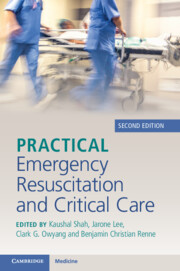Book contents
- Practical Emergency Resuscitation and Critical Care
- Practical Emergency Resuscitation and Critical Care
- Copyright page
- Contents
- Contributors
- Preface
- Section 1 General Critical Care
- Section 2 Infectious Disease Emergencies
- 5 Covid-19
- 6 Sepsis and Septic Shock
- 7 Pneumonia
- 8 Meningitis and Encephalitis
- 9 Infective Endocarditis
- 10 Necrotizing Soft Tissue Infections
- 11 Complications of Human Immunodeficiency Virus (HIV) and Acquired Immunodeficiency Syndrome (AIDS)
- Section 3 Neurological Emergencies
- Section 4 Cardiovascular Emergencies
- Section 5 Respiratory Emergencies
- Section 6 Gastrointestinal Emergencies
- Section 7 Renal Emergencies
- Section 8 Hematology–Oncology Emergencies
- Section 9 Endocrine Emergencies
- Section 10 Environmental Emergencies
- Section 11 Trauma
- Section 12 End of Life
- Index
- References
9 - Infective Endocarditis
from Section 2 - Infectious Disease Emergencies
Published online by Cambridge University Press: 02 November 2023
- Practical Emergency Resuscitation and Critical Care
- Practical Emergency Resuscitation and Critical Care
- Copyright page
- Contents
- Contributors
- Preface
- Section 1 General Critical Care
- Section 2 Infectious Disease Emergencies
- 5 Covid-19
- 6 Sepsis and Septic Shock
- 7 Pneumonia
- 8 Meningitis and Encephalitis
- 9 Infective Endocarditis
- 10 Necrotizing Soft Tissue Infections
- 11 Complications of Human Immunodeficiency Virus (HIV) and Acquired Immunodeficiency Syndrome (AIDS)
- Section 3 Neurological Emergencies
- Section 4 Cardiovascular Emergencies
- Section 5 Respiratory Emergencies
- Section 6 Gastrointestinal Emergencies
- Section 7 Renal Emergencies
- Section 8 Hematology–Oncology Emergencies
- Section 9 Endocrine Emergencies
- Section 10 Environmental Emergencies
- Section 11 Trauma
- Section 12 End of Life
- Index
- References
Summary
Infective endocarditis (IE) is a microbial infection of the endothelial layer of the heart, the valves or both. The mitral valve is most commonly affected, except in patients with intravenous drug use (IVDU), where the tricuspid valve is more commonly affected. Risk factors include age, chronic hemodialysis, poor dentition, valvulopathy, immunocompromised status, diabetes, IVDU, prosthetic valve and implanted cardiac devices. More than 50% of cases of IE occur in patients older than 60 years.
The majority of cases are due to Gram-positive cocci such as Staphylococcus and Streptococcus species. In patients with negative blood cultures and no recent antibiotic use, the organisms are often the HACEK group (Haemophilus, Actinobacillus, Cardiobacterium, Eikenella, Kingella). Approximately 50% of patients require surgical management.
- Type
- Chapter
- Information
- Practical Emergency Resuscitation and Critical Care , pp. 77 - 82Publisher: Cambridge University PressPrint publication year: 2023

